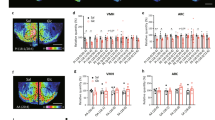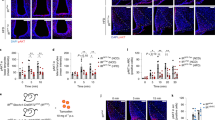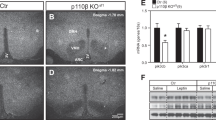Abstract
Increased glucose production is a hallmark of type 2 diabetes and alterations in lipid metabolism have a causative role in its pathophysiology. Here we postulate that physiological increments in plasma fatty acids can be sensed within the hypothalamus and that this sensing is required to balance their direct stimulatory action on hepatic gluconeogenesis. In the presence of physiologically-relevant increases in the levels of plasma fatty acids, negating their central action on hepatic glucose fluxes through (i) inhibition of the hypothalamic esterification of fatty acids, (ii) genetic deletion (Sur1-deficient mice) of hypothalamic KATP channels or pharmacological blockade (KATP blocker) of their activation by fatty acids, or (iii) surgical resection of the hepatic branch of the vagus nerve led to a marked increase in liver glucose production. These findings indicate that a physiological elevation in circulating lipids can be sensed within the hypothalamus and that a defect in hypothalamic lipid sensing disrupts glucose homeostasis.
This is a preview of subscription content, access via your institution
Access options
Subscribe to this journal
Receive 12 print issues and online access
$209.00 per year
only $17.42 per issue
Buy this article
- Purchase on Springer Link
- Instant access to full article PDF
Prices may be subject to local taxes which are calculated during checkout






Similar content being viewed by others
References
Taylor, S.I. Deconstructing type 2 diabetes. Cell 97, 9–12 (1999).
McGarry, J.D. What if Minkowski had been ageusic? An alternative angle on diabetes. Science 258, 766–770 (1992).
McGarry, J.D. Banting lecture 2001: dysregulation of fatty acid metabolism in the etiology of type 2 diabetes. Diabetes 51, 7–18 (2002).
Boden, G. Role of fatty acids in the pathogenesis of insulin resistance and NIDDM. Diabetes 46, 3–10 (1997).
Shulman, G.I. Cellular mechanisms of insulin resistance. J. Clin. Invest 106, 171–176 (2000).
Lam, T.K. et al. Mechanisms of the free fatty acid-induced increase in hepatic glucose production. Am. J. Physiol. Endocrinol. Metab. 284, E863–E873 (2003).
Boden, G., Chen, X., Ruiz, J., White, J.V. & Rossetti, L. Mechanisms of fatty acid-induced inhibition of glucose uptake. J. Clin. Invest. 93, 2438–2446 (1994).
Lam, T.K., van de Werve, G. & Giacca, A. Free fatty acids increase basal hepatic glucose production and induce hepatic insulin resistance at different sites. Am. J. Physiol. Endocrinol. Metab. 284, E281–E290 (2003).
Rebrin, K., Steil, G.M., Mittelman, S.D. & Bergman, R.N. Causal linkage between insulin suppression of lipolysis and suppression of liver glucose output in dogs. J. Clin. Invest. 98, 741–749 (1996).
Sindelar, D.K. et al. The role of fatty acids in mediating the effects of peripheral insulin on hepatic glucose production in the conscious dog. Diabetes 46, 187–196 (1997).
Chu, C.A. et al. Effects of free fatty acids on hepatic glycogenolysis and gluconeogenesis in conscious dogs. Am. J. Physiol. Endocrinol. Metab. 282, E402–E411 (2002).
Chen, X., Iqbal, N. & Boden, G. The effects of free fatty acids on gluconeogenesis and glycogenolysis in normal subjects. J. Clin. Invest. 103, 365–372 (1999).
Boden, G., Chen, X., Capulong, E. & Mozzoli, M. Effects of free fatty acids on gluconeogenesis and autoregulation of glucose production in type 2 diabetes. Diabetes 50, 810–816 (2001).
Miller, J.C., Gnaedinger, J.M. & Rapoport, S.I. Utilization of plasma fatty acid in rat brain: distribution of [14C]palmitate between oxidative and synthetic pathways. J. Neurochem. 49, 1507–1514 (1987).
Loftus, T.M. et al. Reduced food intake and body weight in mice treated with fatty acid synthase inhibitors. Science 288, 2379–2381 (2000).
Obici, S. et al. Central administration of oleic acid inhibits glucose production and food intake. Diabetes 51, 271–275 (2002).
Obici, S., Feng, Z., Arduini, A., Conti, R. & Rossetti, L. Inhibition of hypothalamic carnitine palmitoyltransferase-1 decreases food intake and glucose production. Nat. Med. 9, 756–761 (2003).
Obici, S., Zhang, B.B., Karkanias, G. & Rossetti, L. Hypothalamic insulin signaling is required for inhibition of glucose production. Nat. Med. 8, 1376–1382 (2002).
Matsuhisa, M. et al. Important role of the hepatic vagus nerve in glucose uptake and production by the liver. Metabolism 49, 11–16 (2000).
Moore, M.C. et al. Effect of hepatic nerves on disposition of an intraduodenal glucose load. Am. J. Physiol 265, E487–E496 (1993).
Xue, C. et al. Isolated hepatic cholinergic denervation impairs glucose and glycogen metabolism. J. Surg. Res. 90, 19–25 (2000).
Aguilar-Bryan, L. et al. Cloning of the beta cell high-affinity sulfonylurea receptor: a regulator of insulin secretion. Science 268, 423–426 (1995).
Aguilar-Bryan, L. & Bryan, J. Molecular biology of adenosine triphosphate-sensitive potassium channels. Endocr. Rev. 20, 101–135 (1999).
Seino, S. & Miki, T. Physiological and pathophysiological roles of ATP-sensitive K+ channels. Prog. Biophys. Mol. Biol. 81, 133–176 (2003).
Inagaki, N. et al. A family of sulfonylurea receptors determines the pharmacological properties of ATP-sensitive K+ channels. Neuron 16, 1011–1017 (1996).
Branstrom, R., Corkey, B.E., Berggren, P.O. & Larsson, O. Evidence for a unique long chain acyl-CoA ester binding site on the ATP-regulated potassium channel in mouse pancreatic beta cells. J. Biol. Chem. 272, 17390–17394 (1997).
Gribble, F.M., Proks, P., Corkey, B.E. & Ashcroft, F.M. Mechanism of cloned ATP-sensitive potassium channel activation by oleoyl-CoA. J. Biol. Chem. 273, 26383–26387 (1998).
Morgan, K., Obici, S. & Rossetti, L. Hypothalamic responses to long-chain fatty acids are nutritionally regulated. J. Biol. Chem. 279, 31139–31148 (2004).
Wang, J. et al. Overfeeding rapidly induces leptin and insulin resistance. Diabetes 50, 2786–2791 (2001).
Flier, J.S. Obesity wars: molecular progress confronts an expanding epidemic. Cell 116, 337–350 (2004).
Wojtczak, A.B., Walajtys-Rode, E.I. & Geelen, M.J. Interrelations between ureogenesis and gluconeogenesis in isolated hepatocytes. The role of antion transport and the competition for energy. Biochem. J. 170, 379–385 (1978).
Williamson, J.R., Kreisberg, R.A. & Felts, P.W. Mechanism for the stimulation of gluconeogenesis by fatty acids in perfused rat liver. Proc. Natl. Acad. Sci. USA 56, 247–254 (1966).
Clore, J.N., Glickman, P.S., Nestler, J.E. & Blackard, W.G. In vivo evidence for hepatic autoregulation during FFA-stimulated gluconeogenesis in normal humans. Am. J. Physiol. 261, E425–E429 (1991).
Roden, M. et al. Effects of free fatty acid elevation on postabsorptive endogenous glucose production and gluconeogenesis in humans. Diabetes 49, 701–707 (2000).
Williamson, J.R., Browning, E.T. & Scholz, R. Control mechanisms of gluconeogenesis and ketogenesis. I. Effects of oleate on gluconeogenesis in perfused rat liver. J. Biol. Chem. 244, 4607–4616 (1969).
Pocai, A., Obici, S., Schwartz, G.J. & Rossetti, L. A brain-liver circuit regulates glucose homeostasis. Cell Metab. 1, 53–61 (2005).
McKhann, G.M., D'Ambrosio, R. & Janigro, D. Heterogeneity of astrocyte resting membrane potentials and intercellular coupling revealed by whole-cell and gramicidin-perforated patch recordings from cultured neocortical and hippocampal slice astrocytes. J. Neurosci. 17, 6850–6863 (1997).
Dunn-Meynell, A.A., Rawson, N.E. & Levin, B.E. Distribution and phenotype of neurons containing the ATP-sensitive K+ channel in rat brain. Brain Res. 814, 41–54 (1998).
Miki, T. et al. ATP-sensitive K+ channels in the hypothalamus are essential for the maintenance of glucose homeostasis. Nat. Neurosci. 4, 507–512 (2001).
Vatamaniuk, M.Z., Horyn, O.V., Vatamaniuk, O.K. & Doliba, N.M. Acetylcholine affects rat liver metabolism via type 3 muscarinic receptors in hepatocytes. Life Sci. 72, 1871–1882 (2003).
Obici, S. et al. Central melanocortin receptors regulate insulin action. J. Clin. Invest. 108, 1079–1085 (2001).
Morton, G.J. et al. Arcuate nucleus-specific leptin receptor gene therapy attenuates the obesity phenotype of Koletsky (fa(k)/fa(k)) rats. Endocrinology 144, 2016–2024 (2003).
Combs, T.P., Berg, A.H., Obici, S., Scherer, P.E. & Rossetti, L. Endogenous glucose production is inhibited by the adipose-derived protein Acrp30. J. Clin. Invest. 108, 1875–1881 (2001).
Hansen, A.M. et al. Differential interactions of nateglinide and repaglinide on the human beta-cell sulphonylurea receptor 1. Diabetes 51, 2789–2795 (2002).
Tomoda, H., Igarashi, K., Cyong, J.C. & Omura, S. Evidence for an essential role of long chain acyl-CoA synthetase in animal cell proliferation. Inhibition of long chain acyl-CoA synthetase by triacsins caused inhibition of Raji cell proliferation. J. Biol. Chem. 266, 4214–4219 (1991).
Barzilai, N. et al. Leptin selectively decreases visceral adiposity and enhances insulin action. J. Clin. Invest. 100, 3105–3110 (1997).
la Fleur, S.E., Ji, H., Manalo, S.L., Friedman, M.I. & Dallman, M.F. The hepatic vagus mediates fat-induced inhibition of diabetic hyperphagia. Diabetes 52, 2321–2330 (2003).
Norgren, R. & Smith, G.P. A method for selective section of vagal afferent or efferent axons in the rat. Am. J. Physiol. 267, R1136–R1141 (1994).
Sclafani, A., Ackroff, K. & Schwartz, G.J. Selective effects of vagal deafferentation and celiac-superior mesenteric ganglionectomy on the reinforcing and satiating action of intestinal nutrients. Physiol. Behav. 78, 285–294 (2003).
Acknowledgements
We wish to thank B. Liu, J. Liu, C. Baveghems and S. Gaweda for technical assistance. This work was supported by grants from the US National Institutes of Health (to L. Rossetti, DK 45024, DK 48321 and AG 21654; to G. J. Schwartz, DK 47208; to J. Bryan, DK52771; to L. Aguilar-Bryan, DK57671), from the Albert Einstein College of Medicine Diabetes Research & Training Center (DK 20541). S. Obici is the recipient of a Junior Faculty Award from the American Diabetes Association. T.K.T. Lam is supported by a Training Grant from the National Institute of Aging (T32-AG023475).
Author information
Authors and Affiliations
Corresponding author
Ethics declarations
Competing interests
The authors declare no competing financial interests.
Supplementary information
Supplementary Fig. 1
Tracer verification of the placement of hypothalamic cannulae. (PDF 15 kb)
Supplementary Fig. 2
Hypothalamic expression of SUR1. (PDF 19 kb)
Supplementary Fig. 3
Pivotal role of efferent vagal input to the liver in modulating glucose kinetics. (PDF 69 kb)
Supplementary Fig. 4
Increased lipid availability rapidly induces hyperglycemia in overfed rats. (PDF 22 kb)
Supplementary Table 1
Characteristics of the experimental groups before, during and after the pancreatic clamp glibenclamide studies (PDF 25 kb)
Supplementary Table 2
Glibenclamide studies: specific activities of hepatic substrates used to calculate the direct pathway and the indirect pathway in rats receiving systemic lipid infusions (PDF 22 kb)
Supplementary Table 3
Characteristics of the Sur1 knockout (Sur1KO) vs. WT mice before and during the lipid pancreatic clamp studies (PDF 20 kb)
Supplementary Table 4
Characteristics of the experimental groups before, during and after the pancreatic clamp hepatic vagotomy studies (PDF 25 kb)
Supplementary Table 5
Hepatic vagotomy studies: specific activities of hepativ substrates used to calculate the direct pathway nd the indirect pathway in rats receiving systemic lipid infusions (PDF 21 kb)
Rights and permissions
About this article
Cite this article
Lam, T., Pocai, A., Gutierrez-Juarez, R. et al. Hypothalamic sensing of circulating fatty acids is required for glucose homeostasis. Nat Med 11, 320–327 (2005). https://doi.org/10.1038/nm1201
Received:
Accepted:
Published:
Issue Date:
DOI: https://doi.org/10.1038/nm1201
This article is cited by
-
Simultaneous exposure to electromagnetic field from mobile phone and unimpeded fructose drinking during pre-, peri-, and post-pubertal stages perturbs the hypothalamic and hepatic regulation of energy homeostasis by early adulthood: experimental evidence
Environmental Science and Pollution Research (2022)
-
Hypothalamic inflammation in metabolic disorders and aging
Cellular and Molecular Life Sciences (2022)
-
Stimulation of the hepatoportal nerve plexus with focused ultrasound restores glucose homoeostasis in diabetic mice, rats and swine
Nature Biomedical Engineering (2022)
-
Brain insulin signalling in metabolic homeostasis and disease
Nature Reviews Endocrinology (2021)
-
Activation of GPR40 induces hypothalamic neurogenesis through p38- and BDNF-dependent mechanisms
Scientific Reports (2020)



